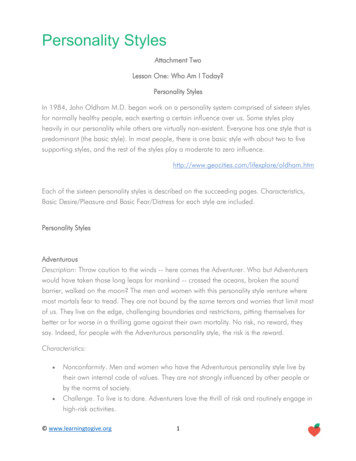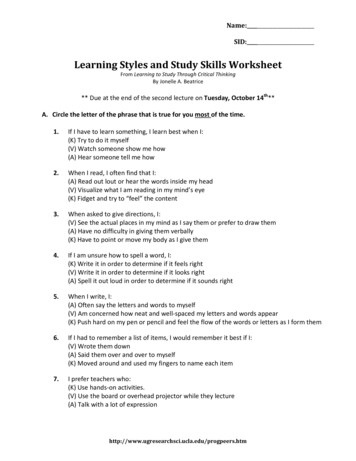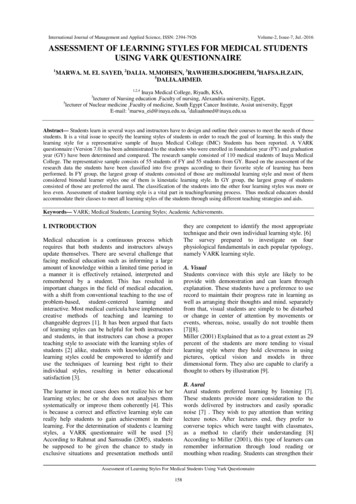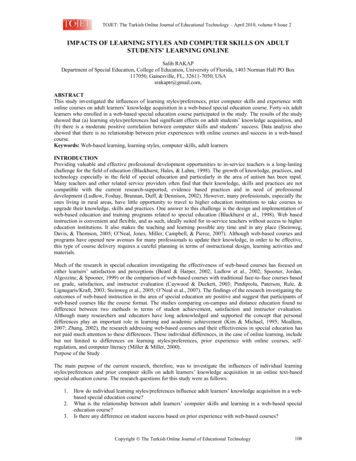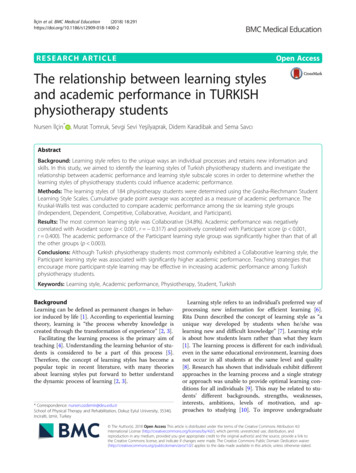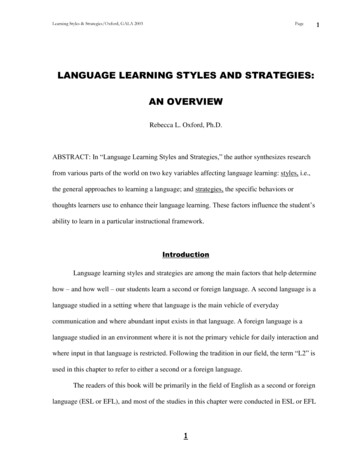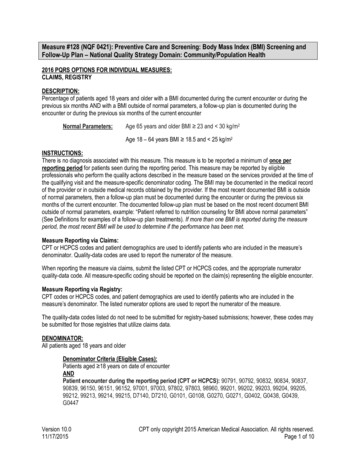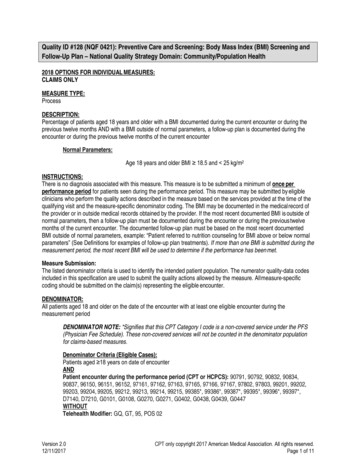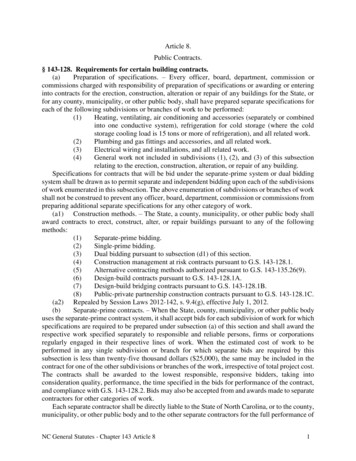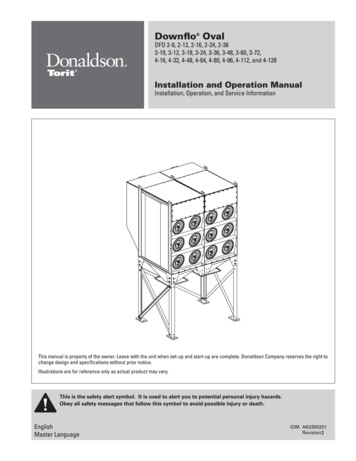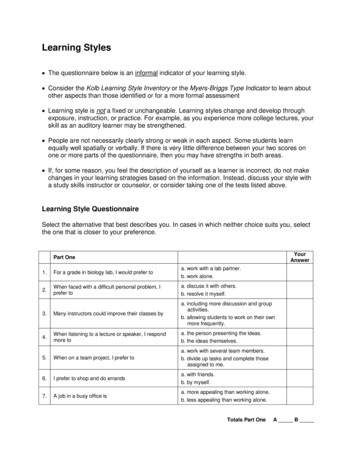
Transcription
Learning Styles The questionnaire below is an informal indicator of your learning style. Consider the Kolb Learning Style Inventory or the Myers-Briggs Type Indicator to learn aboutother aspects than those identified or for a more formal assessment Learning style is not a fixed or unchangeable. Learning styles change and develop throughexposure, instruction, or practice. For example, as you experience more college lectures, yourskill as an auditory learner may be strengthened. People are not necessarily clearly strong or weak in each aspect. Some students learnequally well spatially or verbally. If there is very little difference between your two scores onone or more parts of the questionnaire, then you may have strengths in both areas. If, for some reason, you feel the description of yourself as a learner is incorrect, do not makechanges in your learning strategies based on the information. Instead, discuss your style witha study skills instructor or counselor, or consider taking one of the tests listed above.Learning Style QuestionnaireSelect the alternative that best describes you. In cases in which neither choice suits you, selectthe one that is closer to your preference.YourAnswerPart One1.For a grade in biology lab, I would prefer toa. work with a lab partner.b. work alone.2.When faced with a difficult personal problem, Iprefer toa. discuss it with others.b. resolve it myself.3.Many instructors could improve their classes bya. including more discussion and groupactivities.b. allowing students to work on their ownmore frequently.4.When listening to a lecture or speaker, I respondmore toa. the person presenting the ideas.b. the ideas themselves.5.When on a team project, I prefer toa. work with several team members.b. divide up tasks and complete thoseassigned to me.6.I prefer to shop and do errandsa. with friends.b. by myself.7.A job in a busy office isa. more appealing than working alone.b. less appealing than working alone.Totals Part OneA B
YourAnswerPart Two1.To solve a math problem, I would prefer toa. draw or visualize the problem.b. study a sample problem and use it as amodel.2.To remember things best, Ia. create a mental picture.b. write it down.3.Assembling a bicycle from a diagram would bea. easy.b. challenging.4.I prefer classes in which Ia. handle equipment or work with models.b. participate in a class discussion.5.To understand and remember how a machineworks, I woulda. draw a diagram.b. write notes.6.I enjoya. drawing or working with my hands.b. speaking, writing, and listening.7.If I were trying to locate an office on an unfamiliaruniversity campus, I would prefer a student toa. draw me a map.b. give me a set of written directions.Totals Part TwoA BYourAnswerPart Three1.I prefer toa. learn facts and details.b. construct theories and ideas.2.I would prefer a job involvinga. following specific instructions.b. reading, writing, and analyzing.3.I prefer toa. solve math problems using a formula.b. discover why the formula works.4.I would prefer to write a term paper explaininga. how a process works.b. a theory.5.I prefer tasks that require me to followa. careful, detailed instructions.b. reasoning and critical analysis.6.For a criminal justice course I would prefer toa. discover how and when a law can beused.b. learn how and why it became law.7.To learn more about the operation of a high-speedcomputer printer, I would prefer toa. work with several types of printers.b. understand the principles on which theyoperate.Totals Part ThreeA B
YourAnswerPart Four1.I would prefer to follow a set ofa. oral directions.b. written directions.2.I would prefer toa. attend a lecture given by a famouspsychologist.b. read an article written by the psychologist.3.I am better at rememberinga. names.b. faces.4.It is easier to learn new information usinga. language (words).b. images (pictures).5.I prefer classes in which the instructora. lectures and answers questions.b. uses films and videos.6.To obtain information about current events, I wouldprefer toa. listen to news on the radio.b. read the newspaper.7.To learn how to operate a fax machine, I woulda. listen to a friend’s explanation.b. watch a demonstration.Totals Part FourA BYourAnswerPart Five1.To make decisions I rely ona. my experiences and “gut” feelings.b. facts and objective data.2.To complete a task, Ia. can use whatever is available to get thejob done.b. must have everything I need at hand.3.I prefer to express my ideas and feelings througha. music, song, or poetry.b. direct, concise language.4.I prefer instructors whoa. allow students to be guided by their owninterests.b. make their expectations clear and explicit.5.I tend toa. challenge and question what I hear andread.b. accept what I hear and read6.I prefera. essay exams.b. objective (multiple-choice, true-false)exams.7.In completing an assignment I prefer toa. figure out my own approach.b. be told exactly what to do.Totals Part FiveA B
Scoring GridIn the scoring grid below, record the total number of choice A’s and B’s for each part of thequestionnaire. Circle the word that corresponds to the higher number. The higher numberindicates your dominant learning styles.Total Number of Choice ATotal Number of Choice BPart One(Social)(Independent)Part Two(Spatial)(Verbal)Part Three(Applied)(Conceptual)Part Four(Auditory)(Visual)Part Five(Creative)(Pragmatic)Interpreting Your ScoresThe questionnaire was divided into five parts; each part identifies one aspect of your learning style. Eachof these five aspects is explained below.Part One—Social or Independent LearnersThis score reveals your preferred level of interaction with other people in the learning process. If you area social learner, you prefer to work with others both peers and instructors—closely and directly. Sociallearners tend to be people-oriented and enjoy personal interaction. If you are an independent learner, youprefer to work and study alone. You tend to be self-directed or self-motivated, and you are often goaloriented.Part Two—Spatial or Verbal LearnersThis score reveals your ability to work with spatial relationships. Spatial learners are able to visualize ormentally see how things work or how they are positioned in space. Their strengths may include drawing,assembling things, or repairing. Verbal learners lack skills in positioning things in space. Instead they tendto rely on verbal or language skills.Part Three—Applied or Conceptual LearnersThis score describes the types of learning tasks and learning situations you prefer and find easiest tohandle. If you are an applied learner, you prefer tasks that involve real objects and situations. Practical,real-life learning situations are ideal for you. Examples will often make an idea clear and understandable.If you are a conceptual learner, you prefer to work with language and ideas; practical applications are notnecessary for understanding. You may enjoy working with theories and concepts and tend to work fromrule to example.Part Four—Auditory or Visual LearnersThis score indicates through which sensory mode you prefer to process information. Auditory learnerstend to learn more effectively through listening, while visual learners process information by seeing it inprint or other visual modes including film, picture, or diagram. If you have a higher score on auditory thanvisual, you tend to be an auditory learner. That is, you tend to learn more easily by hearing than byreading. A higher score in visual suggests strengths with visual modes of learning.Part Five—Creative or Pragmatic LearnersThis score describes the approach you prefer to take toward learning tasks. Creative learners areimaginative and innovative. They prefer to learn through discovery or experimentation. They arecomfortable taking risks and following hunches. Pragmatic learners are practical, logical, and systematic.They seek order and are comfortable following rules.
Learning Strategies for Various Learning StylesSocial1. Interact with instructor.2. Find a study partner.3. Form a study group.4. Take courses involving class discussion.5. Work with a tutor.Spatial1. Draw diagrams, make charts and sketches.2. Use outlining.3. Use visualization.4. Use mapping (see Chapter 15).Applied1. Associate ideas with their application.2. Take courses with a lab or practicum.3. Think of practical situations to which learningapplies.4. Use case studies, examples, and applications tocue your learning.Auditory1. Tape-record review notes.2. Discuss/study with friends.3, Talk aloud when studying.4. Tape-record lectures.Creative1. Take courses that involve exploration,experimentation, or discussion.2. Use annotation to record impressions andreactions.3. Ask questions about chapter content and answerthem.Independent1. Use computer-assisted instructions if available.2. Enroll in courses using traditional lecture-examformat.3. Consider independent study courses.4. Purchase review books and study guides, ifavailable.Verbal1. Record steps, processes, procedures in words,2. Write summaries.3. Translate diagrams and drawings into language.4. Write your interpretation next to textbookdrawings, maps, and graphics.Conceptual1. Use outlining.2. Focus on thought patterns (see Chapter 12).3. Organize materials into rules and examples.Visual1. Use concept mapping.2. Use visualization.3. Use computer-assisted instructions if available.4. Use films and videos when available.5. Draw diagrams, charts, maps.Pragmatic1. Write lists of steps, processes, and procedures.2. Write summaries and outlines.3. Use structured study environment.4. Focus on problem-solving logical sequence.Adapting to Various Teaching StylesSome instructors are very applied; they teach by example. Others are more conceptual; theyfocus on presenting ideas, rules, theories, and so forth.The subject matter may also dictate how the instructor teaches. A biology instructor, forinstance, has a large body of factual information to present and may feel he or she has little timeto schedule group interaction.Comparing Learning and Teaching StylesCompare your learning style to the teaching styles of your instructors. You can begin to see whymay learn better from one instructor than another and why you feel more comfortable in certaininstructors’ classes than others. When your learning style does not correspond to an instructor’steaching style, learning will be more of a challenge. You may have to work harder in that classby taking extra steps to reorganize or reformat the material into a form in which you can learn itbetter. The following section presents each of the five categories of learning-teaching styles andsuggests how you might make changes in how you study to accommodate each.
Social-IndependentIf your instructor organizes numerous in-class group activities and you tend to bean independent learner, then you will need to spend time alone after class reviewing the classactivity, making notes, perhaps even repeating the activity by yourself to make it moremeaningful. If your instructor seldom structures in-class group activities and you tend to be asocial learner, arrange or join a study group or study with a classmate.Spatial-VerbalIf you are a spatial learner and your instructor has a verbal teaching style (he or she lecturesand writes notes on the board), then you will need to draw diagrams, charts, and pictures tolearn the material. On the other hand, if you are a verbal learner and your instructor is spatial(he or she frequently uses diagrams, flowcharts, and so forth), then you may need to translatethe diagrams and flowcharts into words in order to learn them more easily.Applied-ConceptualIf your instructor seldom uses examples, models, or case studies and you are an appliedlearner, you need to think of your own examples to make the course material real andmemorable to you. Leave space in your class notes to add examples. Add them during class ifthey come to mind; if not, take time as you review your notes to add examples. If your instructoruses numerous demonstrations and examples and you are a conceptual learner, you may needto leave space in your class notes to write in rules or generalizations that state what theexamples are intended to prove.Auditory-VisualIf your instructor announces course information (such as paper assignments, class projects, ordescriptions of upcoming exams) orally and you are a visual learner, you should record as muchinformation as possible in your notes. If your instructor relies on lectures to present new materialnot included in your textbook, taking complete lecture notes is especially important. If yourinstructor uses numerous visual aids and you tend to be an auditory learner, consider taperecording summaries of these visual aids.Creative-PragmaticSuppose your instructor is very systematic and organized in his or her lectures, and, as acreative learner, you prefer to discover ideas through experimentation and free-flowingdiscussion. Then you should consider creating a column in your class notes to record yourresponses and creative thoughts or reserving the bottom quarter of each page for suchannotations. If your instructor is creative and tends to use a loose or free-flowing class format,and you tend to be a pragmatic learner, you may need to rewrite and restructure class notes. Ifhe or she fails to give you specific guidelines for completing activities or assignments, youshould talk with your instructor or ask for more information.Adapted from McWhorter, K. T. (2003). Study and critical thinking skills in college (5th ed.). New York: Addison Wesley Longman, Inc.
Learning Strategies for Various Learning Styles Social 1. Interact with instructor. 2. Find a study partner. 3. Form a study group. 4. Take courses involving class discussion. 5. Work with a tutor. Independent 1. Use computer-assisted instructions if available. 2. Enroll in courses using traditional lecture-exam format. 3. Consider independent study courses. 4. Purchase review books and study guides, if

